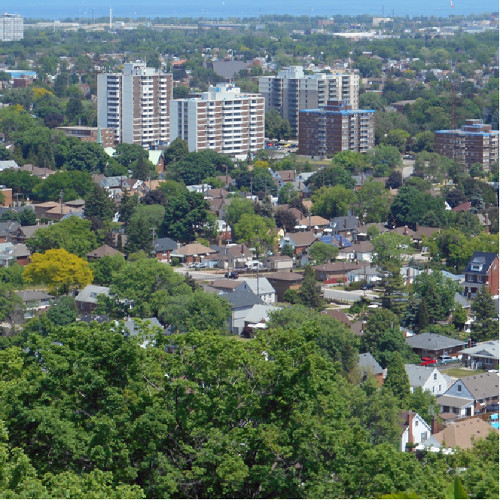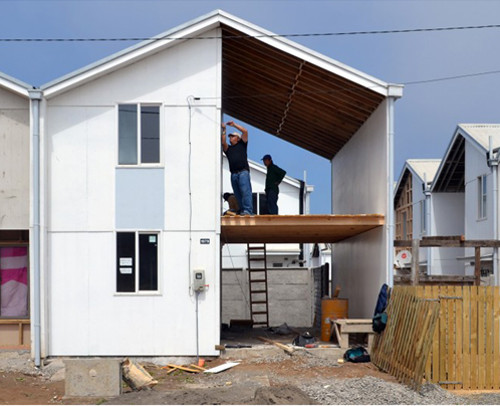Tn the case of securitized cash flow from Hamilton high-rises, the combination of market forces and regulations seems to work against the upkeep of buildings.
By Shawn Selway
Published August 17, 2016
This is the third part of a three-part series. You can read part 1, part 2.

Downtown living. Minority religions persist alongside the dominant capitalist faith.
During a summer of severe job shortages many years ago, I signed on with the Royal Hamilton Light Infantry (RHLI) for militia training. It paid a modest stipend and was physically less taxing than stacking bags of fertilizer at the CIL plant; but it was mentally excruciating, owing largely to the hurry-up-and-wait character of life at the bottom of any strict hierarchy.
Of course there were memorable moments: first Black Sabbath tune, for instance. Definitely a life-changer.
Another was the recognition, achieved while our platoon was crawling across a newly-mown field on our elbows, that the life of an infantryman is one endless season of unknowing. You never know why you are where you are; you never know what will happen next. The thinking is forever beyond you.
It did not occur to me at the time that, had I been able to review a complete statement of the plan in which I was a speck, I might still not have known what was going on, owing to an inability to actually understand the terms in which the plan was expressed.
I mention this because, on perusing Northview's annual report for 2015, I felt like that lowly foot soldier in the stubble field again, but now with access to the plan. Only I lacked the knowledge needed to entirely comprehend what I was reading. Much however was clear enough. For example, the partial list of "Strategic Value Creation Initiatives" needed no translation.
(i) Execute high-end renovation program: Management has identified several properties acquired in the Transaction that will undergo a significant renovation to increase rental rates. These renovations will involve extensive upgrades to many of the properties common areas and high-end in-suite improvements, including: enhanced landscaping and complete bathroom and kitchen renovations. The expected post renovation increase in rents is approximately $250 to $300 per month and provides a return on equity of 15 to 20% on the additional capital invested.
(ii) Address below market rents: At the time of the Transaction, monthly rents in the portfolios acquired were on average $32 below current market rents. Management believes these rents can be moved to market levels on turnover, with the completion of standard renovations.
(iii) Complete sub-metering program: The sub-metering program in Ontario provides individual electric meters for each suite, which allows tenants to pay their electricity bill directly. On tenant turnover, this reduces the utility costs to the landlord, which could result in estimated average monthly savings of $40 per suite.
(iv) Above guideline increases: The significant capital that has been invested in the assets acquired in the Transaction has enabled management to submit applications to the Ontario Landlord and Tenant Board to increase rents by more than the regulated annual increase. These AGI's have resulted in rental rates increasing by approximately 4% compared to the 1.6% permitted in Ontario in 2015.
This is a straightforward declaration of class war, which boils down to this: make them pay more, or get them out and get in someone who can.
Some of the perplexity felt by tenants and outside observers of the current situation arises from the initial difficulty of grasping just how irrelevant the state of the building is to the managers of a REIT portfolio, despite publicity to the contrary.
Of course, if the balconies begin to drop off or the boiler expires, it matters, because an external party may intervene and oblige the owners to divert cash to repairs. Otherwise, the state of the building is of little consequence.
In acquiring 150, 155 and 160 Market, the Northview strategists were buying not buildings but a cash flow. The source of the flow, the underlying asset, could be bags of coffee or sugar, mineral royalties, medical facilities in the U.S., chunks of student debt, or whatever you can think of.
This is the securitization problem: the tendency for the physical character of an asset to recede behind financial manipulations and so become increasingly irrelevant to its owner, and therefore negligible and therefore tending to deteriorate. To use the classic distinction, the tenants are concerned with the use value of the building and their apartment, while the owners are fixated on the exchange value.
For practical purposes, use value is a qualitative concept. With respect to the mobile renter of a generic city apartment tower unit, the only ready quantitative measure of use value is length of tenure, which indicates a degree of satisfaction with the dwelling itself, any associated amenities, and its location.
This last factor is probably the most important in guiding tenants' decisions and includes relative transportation costs and other considerations unique to each individual e.g. the proximity of a workplace or a particular clinic, or of a sibling who can offer babysitting services or companionship, and so on.
Locational advantages will tend to offset dissatisfaction with the shabbiness of the apartment, or vice versa, but eventually, in a fluid market, a tipping point will be reached and the tenant will switch homes.
However, as satisfaction declines, the tenant may not be able to express it by moving because there is no better place to go, or, if there is, the cost of the move itself may preclude it.
Of course, a fluid market is just what we have not got at the moment. Few new rental units are becoming available, and the existing stock is increasingly more desirable, both for its use value and its exchange value.
In the recent past, centrality has been a strong preference for a certain class of tenants in Hamilton, but it is now becoming more widely desired. The change which is occurring is a re-partition of overall demand.
For fifty years, the strong preference was for a radically simplified geography, that of the retail complex, school, and television set, mediated by the automobile. That choice continues to be favoured by many, but it is increasingly denigrated as experientially impoverished, and there is a return to the social and architectural complexities and varied cultural layers of the historic city centre.
At the same time, these same apartment units have become very attractive to seekers of exchange value, for reasons mentioned earlier. Moreover, the cash-flow generated by large multi-residential buildings is being incorporated into ever larger pools of capital, and the managers of that capital are very demanding.

'...It's like a horse that has to eat every day.' Developer Edoardo Nottola (Rod Steiger) gets down to basics with his local party boss in Francesco Rosi's timeless real estate primer, Hands Over the City. Still from the Criterion Collection version of the film.
One of Starlight's partners in the 2012 privatization of Trans Globe was the Canada Pension Plan (CPP) Board. Institutional funds like those managed by the CPP Board, the Municipal Employees pension fund and the Ontario Teachers pension fund are increasingly integrated with global capital coming from all sources.
A sense of the complications which this intermingling of global capital brings can be had from a "condition of England" piece that James Meek wrote for the London Review of Books in the spring of 2015.
While digging for the roots of the UK Independence Party in the English outback, Meek visited the faltering town of Grimsby. A once-strong fishing port, now the largest node in the UK for the shipment of cars in and out of the country, Grimsby is trying to return to the sea as a wind-farming centre. Meek is not surprised to find that the majority ownership in the port lies with two Canadian pension funds.
Thatcher hoped that privatisation would create globe-straddling British companies owned by small British shareholders, but instead most of the privatised firms and their small shareholders have been bought out by foreign governments and overseas pension funds. Thus Associated British Ports, which owns the ports of Grimsby and Immingham, as well as Hull and many others around the country, used to be publicly owned, then was owned by anyone with the means and the desire to buy its shares on the stock market, and is now one-third owned by the government of Singapore and one-third by the pension fund of former municipal employees of the Canadian province of Ontario, with a quarter just bought by the Canadian national pension fund and the remaining 10 per cent snapped up by a British investment house, Hermes.
In a way that will be familiar to Hamiltonians, the port authority's ownership of the entire waterfront blocks the municipal council from taking advantage of its main natural asset, and the managers of the port are simply not in the business of maintaining or redeveloping the derelict end of town.
The CPP Investment Board has become fond of infrastructure. After collecting forty percent of Highway 407 in 2010 (the rest is split between Ferrovial and SNC Lavalin, construction companies based in Spain and Canada respectively), CPP and the Teachers recently bought forty-nine percent of the Arco Norte, a toll highway around Mexico City.
The rationale for the buy is that as a "near-shoring option", Mexico's manufacturing industry now has costs on a par with China's, when northward transportation expenses are taken into account. (Globe and Mail, 10 June 2016, Teachers and CPPIB buy into Mexican Toll Highway)
The difference, of course, is that whatever the level of corruption in China, the Chinese state retains a monopoly on the use of force, while the Mexican State has lost or bargained away its own authority, and lacks the capacity, or the will, to limit corruption.
Given the dubious nature of a placement like that, it would make sense for the pension funds to hedge by buying a Canadian or American residential REIT, if a large enough candidate were to appear. Whether the CPP board would have any more interest in the situation of Hamilton tenants than they do in that of the inhabitants of Grimsby, U.K., is doubtful.

The GTHA high-rise archipelago extends around the end of the lake from Toronto to St Catharines, with clusters in Toronto and Hamilton.
However, it is not only the tenants who have an interest in preserving the livability of the multi-residential housing stock. Policy-makers and politicians, whose role is the maintenance of social orderliness through the chaos-making gyrations of the "business cycle" must attend to the matter as well.
The issue is particularly important in southern Ontario because of the comparatively high proportion of the population housed in this type of structure. Very roughly, there are about a million people in the region centred on the GTHA and extending west to Kitchener and east to St Catherines, living in about 2000 buildings over eight stories in height, mostly built before 1975.
A decline in the structural integrity, services or the state of individual units could become a large political problem.
Theoretically, the condition of their properties might be of concern also to REIT shareholders. One might expect them to fear that a deterioration of the buildings would reduce its eventual exchange value and so put not only their return but also their principal at risk.
But this is the beauty (and the danger) of securitization, the process of bundling together commodities of various sorts and selling them off in pieces to individuals and institutions that have income or profits which they need to re-invest.
With securitization the value of the asset is relativized, that is, partly determined by comparison with other assets in other places and the likelihood of their returning a better yield with more certainty.
Exchange value floats free of the "fundamentals", as physical facts - like the percentage of iron in an ore or the quality of the paint applied to a door - are termed in bizspeak. Securitized risk is not only spread widely, but also may be more or less concealed.
In the case of the notorious "mortgage-backed securities" and their derivatives, which caused so much grief in the US in 2007-8, securitization became a means to obscure and finally to eliminate price signals for a portion of the real estate market. This was a serious attack by capital on the basis of the market economy, and ultimately required state intervention on an enormous scale.
Since the RTA prescribes that an AGI application include details about rents as well as capital expenditures (but not maintenance costs), it is possible to use this information to perform rough calculations which give a sense of how the combination of REIT imperatives and the LTB regime conditions the character and cost of residential rental space.
We begin with a determination of so-called Net Present Value as at July 2015. The first step is to simply add up all the rents being paid at say, 160 Market. However, in 2015 Northview was reporting an oddly elevated vacancy rate of 11 percent (19 apartments out of a total of 168).
Since a figure of zero is given for the rent on these vacant units, we have to interpolate a guess, namely, the average rent for all occupied units, which is $790. This yields a total annual rental income at 160 Market Street of about $1,585,000 as of mid-2015.
This is Northview's gross income from the property, and it is this number which is used to estimate the market value of the building. First, we subtract an amount for maintenance costs from gross revenue, say half, leaving net revenue of $790,000.
Now we employ a measure called the capitalization rate, or the discount rate, to arrive at an estimate of the building's value. This is a ratio, obtained by comparing similar assets in the same vicinity, which describes the rate of return on capital expected by investors for a commodity like this in similar circumstances.
Charts for this rate cite them for a number of cities in a number of real-estate investment categories. For example, CBRE, a large real estate consultancy, provides rates for: downtown office, suburban office, industrial, retail, hotel and apartment; with sub categories: apartment high-rise A, high rise B, downtown office, suburban office, etc.
These charts guide the prospective real estate shopper around the commercial landscape, essentially showing the difference between parking your money in the bank, picking up something that pays better than the bank in your home town or elsewhere, perhaps even overseas; or, if none of these choices is satisfactory, getting into some other commodity altogether.
What these numbers mean for our purposes is that, in a locality where an investor expects, say, a five percent return on their money, then a return of $790,000 a year is worth $15.8 million i.e. this is what you have to place somewhere at five percent to get an annual return of $790,000. (The tax-assessed value for 2016 is $10,670,000)
It is straightforward to construct a table in which both total operating costs and the discount rate are varied in order to produce a range of market values for 160 Market Street.
Of course, this is not the only way to estimate the value of a building and the exercise omits some factors, notably carrying costs - or rather, it lumps them in with operating costs and taxes - but for our purposes this is irrelevant.
The utility of producing such a set of numbers is not in how accurately they reflect actual costs or "true" market value, but rather in allowing us to look at some explanatory relations.
| Revenue | opex as a % | opex | net operating income | applying discount rate % to infer value of bldg | |||
|---|---|---|---|---|---|---|---|
| 3 | 4 | 5 | 6 | ||||
| 1,583,544 | 40 | 633,418 | 950,126 | 31,670,880 | 23,753,160 | 19,002,528 | |
| 1,583,544 | 50 | 791,772 | 791,772 | 26,392,400 | 19,794,300 | 15,385,440 | 13,196,200 |
| 1,583,544 | 60 | 950,126 | 633,418 | 15,385,440 | 12,668,352 | ||
| 1,583,544 | 70 | 1,108,481 | 475,063 | 9,501,264 | |||
Consider the relation between rent increases and building value. In the case of 160 Market, Northview was seeking rental increases of 4.6 percent over two years on top of the automatically allowable 3.6 percent guideline increase.
Let us assume that 3.6 covers the actual increase in operating costs for the building over two years. The above guideline increases of 4.6 percent would have amounted, after the second year, to a total raise in rents of about 46,000 dollars annually.
This means that at a discount rate of five percent, the building's overall value would have increased by about ($46,000/0.05) $920,000 in two years. Since the measure of a building's value is the size of its cash flow, as long as tenants have nowhere else to go and must pay the rent, the owner has no incentive to improve any unit.
That is because, on the one hand, the tenant has no alternative, and on the other hand, if the tenant does get fed up with the broken cupboard doors and leaky windows and unreliable elevators and leave, the rent can be hiked without having to go the Board for approval.
In these circumstances, tenants living in a REIT-owned building who wish to maintain or enhance the use-value of their apartment will have to combine with each other, first of all to ensure that their neighbours are aware of the landlord's overall short -term strategy, and then to formulate an appropriate and proportionally aggressive counter-strategy. This strategy might include the following.
1) Persist. Stay in the unit to preserve locational advantage and current rental cost. In the current tight market with all rents rising along with home ownership costs, while wages stagnate or fall in terms of real buying power, tenants are generally better off to stay where they are. As we saw above, Northview managers believe, or affect to believe for purposes of persuading potential investors to buy in, that some units may be able to return 15 to 20 percent on turnover.
The rest will offer less, but still over guideline. Getting to turnover is therefore a strong drive as this offers the possibility of greatest yield. Property management companies have developed tactics to hasten turnover, and knowledge of those tactics and counters to them is locally available, though this is not the appropriate place to discuss them.
2) The landlord has an incentive to avoid maintenance and repairs to individual units, since poor condition may encourage turnover. This implies that tenants must go on the offensive collectively and campaign vigorously for upkeep and upgrades pursue remedies under the RTA as well as under municipal property standards bylaws.
3) Involve external stakeholders in order to offset the political influence of REIT shareholders and managers. The Federation of Rental-Housing Providers of Ontario and their affiliated associations are continuously lobbying the province with their views on rent control, development charges and so on.
Connect with environmentalists and provincial and municipal planners on larger, long-term issues like energy efficiency and the protection of the concrete structural frames of high-rise buildings, where there is a potential to lower costs for the benefit of renters. The REIT focus on short-term gains works against this sort of initiative.

Prime downtown investment property.
The housing market is broken - or not, depending on whether you are in it as an owner or not, and especially, how long you've been in. For new buyers who have taken on big debt to get in, a drop in re-sale prices obviously would strand them with a property worth less than they have paid, at least in the short term.
Even so, many people in the desperate Toronto market are willing to engage in the private war of each against all and compete frantically to trample each other underfoot.
Meanwhile, tenants are inexorably squeezed between shrinking incomes and rising rents, and almost no one except them will acknowledge that the market as structured cannot supply affordable housing, defined as a proportion of income, to either renters or would-be owners.
Efforts by the tenants of multi-residential buildings to resist AGIs and to oblige owners to make repairs will be perceived by the REITs as an attack on their share price, since slowing the rate of increase of the cash flow to the investors may prompt them to shop around for another place to put their money.
In short, in the case of securitized cash flow from Hamilton high-rises, the combination of market forces and the regulations which have been put in place to avoid confronting market failure seems to work against the upkeep of buildings, whatever the rhetoric might be.
The latest political attempt to save the market from its fundamental contradictions is the notion of inclusionary zoning. In the absence of organized collective resistance to market forces by tenants or would-be home buyers, and given the lack of political will to look beyond the market for solutions, inclusionary zoning is probably better than nothing.
But ultimately its effect can only be to push down land prices, since, unless there is a serious technical innovation, the only way a developer can maintain profits is to pay less for the land.
The province is indicating that the choice for or against inclusionary zoning will be left to municipal governments. Locally, this will likely be a difficult decision.
The City owns about a quarter of the West Harbour, lands in which Council has placed its hopes for a symbolic victory over thirty years of perceived decline. Development in the West Harbour would also chime well with provincial preferences for intensification near the centre over continued lower density expansion at the edge.
However, were Council to insist that a certain proportion of West Harbour building be affordable units, the City's expected return on the land would have to fall.
This brings us to the heart of the problem. In order to get to affordability, either land must be taken off the market, or the costs of putting structures on the land and of keeping them in repair over decades of use must change. But that is another discussion, one about building type and technologies, and alternate forms of land tenure - a discussion which we have not been having here in Hamilton.
Ultimately, it seems inevitable that some much larger portion of the housing sector will have to be built as a public utility, like the entirety of the road transportation system is now. We could save a lot of time money and grief if we started working out the details of that solution sooner rather than later.

Self-built housing designed by Elemental, a Chilean architectural firm that concentrates on use-value when thinking about housing. (Image Credit: Elemental)
You must be logged in to comment.
There are no upcoming events right now.
Why not post one?